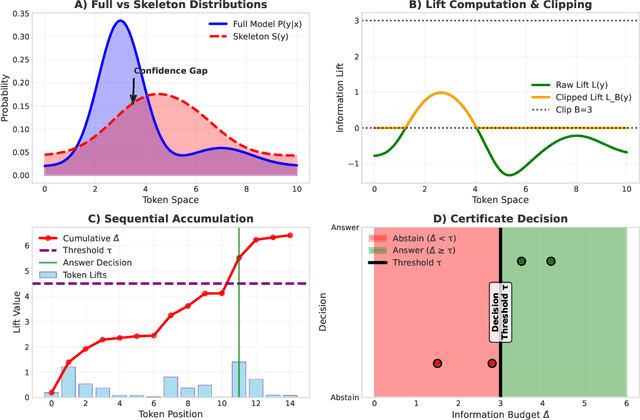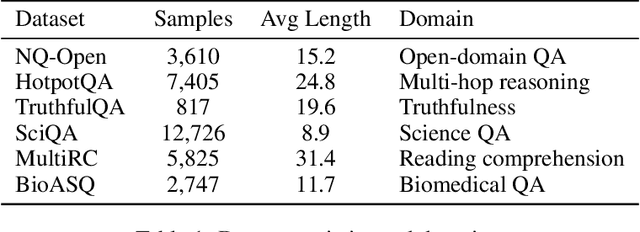Anuj Sharma
Selective Risk Certification for LLM Outputs via Information-Lift Statistics: PAC-Bayes, Robustness, and Skeleton Design
Sep 16, 2025



Abstract:Large language models often produce plausible but incorrect outputs. Existing heuristics such as HallBayes lack formal guarantees. We develop the first comprehensive theory of \emph{information-lift certificates} under selective classification. Our contributions are: (i) a PAC-Bayes \emph{sub-gamma} analysis extending beyond standard Bernstein bounds; (ii) explicit skeleton sensitivity theorems quantifying robustness to misspecification; (iii) failure-mode guarantees under assumption violations; and (iv) a principled variational method for skeleton construction. Across six datasets and multiple model families, we validate assumptions empirically, reduce abstention by 12--15\% at the same risk, and maintain runtime overhead below 20\% (further reduced via batching).
What Fundamental Structure in Reward Functions Enables Efficient Sparse-Reward Learning?
Sep 04, 2025Abstract:What fundamental properties of reward functions enable efficient sparse-reward reinforcement learning? We address this question through the lens of low-rank structure in reward matrices, showing that such structure induces a sharp transition from exponential to polynomial sample complexity, the first result of this kind for sparse-reward RL. We introduce Policy-Aware Matrix Completion (PAMC), which connects matrix completion theory with reinforcement learning via a new analysis of policy-dependent sampling. Our framework provides: (i) impossibility results for general sparse reward observation, (ii) reward-free representation learning from dynamics, (iii) distribution-free confidence sets via conformal prediction, and (iv) robust completion guarantees that degrade gracefully when low-rank structure is only approximate. Empirically, we conduct a pre-registered evaluation across 100 systematically sampled domains, finding exploitable structure in over half. PAMC improves sample efficiency by factors between 1.6 and 2.1 compared to strong exploration, structured, and representation-learning baselines, while adding only about 20 percent computational overhead.These results establish structural reward learning as a promising new paradigm, with immediate implications for robotics, healthcare, and other safety-critical, sample-expensive applications.
Differentiable Entropy Regularization for Geometry and Neural Networks
Sep 03, 2025Abstract:We introduce a differentiable estimator of range-partition entropy, a recent concept from computational geometry that enables algorithms to adapt to the "sortedness" of their input. While range-partition entropy provides strong guarantees in algorithm design, it has not yet been made accessible to deep learning. In this work, we (i) propose the first differentiable approximation of range-partition entropy, enabling its use as a trainable loss or regularizer; (ii) design EntropyNet, a neural module that restructures data into low-entropy forms to accelerate downstream instance-optimal algorithms; and (iii) extend this principle beyond geometry by applying entropy regularization directly to Transformer attention. Across tasks, we demonstrate that differentiable entropy improves efficiency without degrading correctness: in geometry, our method achieves up to $4.1\times$ runtime speedups with negligible error ($<0.2%$); in deep learning, it induces structured attention patterns that yield 6% higher accuracy at 80% sparsity compared to L1 baselines. Our theoretical analysis provides approximation bounds for the estimator, and extensive ablations validate design choices. These results suggest that entropy-bounded computation is not only theoretically elegant but also a practical mechanism for adaptive learning, efficiency, and structured representation.
FedProtoKD: Dual Knowledge Distillation with Adaptive Class-wise Prototype Margin for Heterogeneous Federated Learning
Aug 27, 2025Abstract:Heterogeneous Federated Learning (HFL) has gained attention for its ability to accommodate diverse models and heterogeneous data across clients. Prototype-based HFL methods emerge as a promising solution to address statistical heterogeneity and privacy challenges, paving the way for new advancements in HFL research. This method focuses on sharing only class-representative prototypes among heterogeneous clients. However, these prototypes are often aggregated on the server using weighted averaging, leading to sub-optimal global knowledge; these cause the shrinking of aggregated prototypes, which negatively affects the model performance in scenarios when models are heterogeneous and data distributions are extremely non-IID. We propose FedProtoKD in a Heterogeneous Federated Learning setting, using an enhanced dual-knowledge distillation mechanism to improve the system performance with clients' logits and prototype feature representation. We aim to resolve the prototype margin-shrinking problem using a contrastive learning-based trainable server prototype by leveraging a class-wise adaptive prototype margin. Furthermore, we assess the importance of public samples using the closeness of the sample's prototype to its class representative prototypes, which enhances learning performance. FedProtoKD achieved average improvements of 1.13% up to 34.13% accuracy across various settings and significantly outperforms existing state-of-the-art HFL methods.
Large Language Models for Crash Detection in Video: A Survey of Methods, Datasets, and Challenges
Jul 02, 2025Abstract:Crash detection from video feeds is a critical problem in intelligent transportation systems. Recent developments in large language models (LLMs) and vision-language models (VLMs) have transformed how we process, reason about, and summarize multimodal information. This paper surveys recent methods leveraging LLMs for crash detection from video data. We present a structured taxonomy of fusion strategies, summarize key datasets, analyze model architectures, compare performance benchmarks, and discuss ongoing challenges and opportunities. Our review provides a foundation for future research in this fast-growing intersection of video understanding and foundation models.
Unlocking Insights Addressing Alcohol Inference Mismatch through Database-Narrative Alignment
Jun 24, 2025Abstract:Road traffic crashes are a significant global cause of fatalities, emphasizing the urgent need for accurate crash data to enhance prevention strategies and inform policy development. This study addresses the challenge of alcohol inference mismatch (AIM) by employing database narrative alignment to identify AIM in crash data. A framework was developed to improve data quality in crash management systems and reduce the percentage of AIM crashes. Utilizing the BERT model, the analysis of 371,062 crash records from Iowa (2016-2022) revealed 2,767 AIM incidents, resulting in an overall AIM percentage of 24.03%. Statistical tools, including the Probit Logit model, were used to explore the crash characteristics affecting AIM patterns. The findings indicate that alcohol-related fatal crashes and nighttime incidents have a lower percentage of the mismatch, while crashes involving unknown vehicle types and older drivers are more susceptible to mismatch. The geospatial cluster as part of this study can identify the regions which have an increased need for education and training. These insights highlight the necessity for targeted training programs and data management teams to improve the accuracy of crash reporting and support evidence-based policymaking.
Image Segmentation with Large Language Models: A Survey with Perspectives for Intelligent Transportation Systems
Jun 17, 2025Abstract:The integration of Large Language Models (LLMs) with computer vision is profoundly transforming perception tasks like image segmentation. For intelligent transportation systems (ITS), where accurate scene understanding is critical for safety and efficiency, this new paradigm offers unprecedented capabilities. This survey systematically reviews the emerging field of LLM-augmented image segmentation, focusing on its applications, challenges, and future directions within ITS. We provide a taxonomy of current approaches based on their prompting mechanisms and core architectures, and we highlight how these innovations can enhance road scene understanding for autonomous driving, traffic monitoring, and infrastructure maintenance. Finally, we identify key challenges, including real-time performance and safety-critical reliability, and outline a perspective centered on explainable, human-centric AI as a prerequisite for the successful deployment of this technology in next-generation transportation systems.
Efficient Unstructured Pruning of Mamba State-Space Models for Resource-Constrained Environments
May 13, 2025Abstract:State-space models (SSMs), particularly the Mamba architecture, have emerged as powerful alternatives to Transformers for sequence modeling, offering linear-time complexity and competitive performance across diverse tasks. However, their large parameter counts pose significant challenges for deployment in resource-constrained environments. We propose a novel unstructured pruning framework tailored for Mamba models that achieves up to 70\% parameter reduction while retaining over 95\% of the original performance. Our approach integrates three key innovations: (1) a gradient-aware magnitude pruning technique that combines weight magnitude and gradient information to identify less critical parameters, (2) an iterative pruning schedule that gradually increases sparsity to maintain model stability, and (3) a global pruning strategy that optimizes parameter allocation across the entire model. Through extensive experiments on WikiText-103, Long Range Arena, and ETT time-series benchmarks, we demonstrate significant efficiency gains with minimal performance degradation. Our analysis of pruning effects on Mamba's components reveals critical insights into the architecture's redundancy and robustness, enabling practical deployment in resource-constrained settings while broadening Mamba's applicability.
Cache-Efficient Posterior Sampling for Reinforcement Learning with LLM-Derived Priors Across Discrete and Continuous Domains
May 12, 2025Abstract:Integrating large language models (LLMs) as priors in reinforcement learning (RL) offers significant advantages but comes with substantial computational costs. We present a principled cache-efficient framework for posterior sampling with LLM-derived priors that dramatically reduces these costs while maintaining high performance. At the core of our approach is an adaptive caching mechanism, where cache parameters are meta-optimized using surrogate gradients derived from policy performance. This design enables efficient inference across both discrete text environments (e.g., TextWorld, ALFWorld) and continuous control domains (e.g., MuJoCo), achieving a 3.8--4.7$\times$ reduction in LLM queries and 4.0--12.0$\times$ lower median latencies (85--93\,ms on a consumer GPU) while retaining 96--98\% of uncached performance. Our theoretical analysis provides KL divergence bounds on approximation quality, validated empirically. The framework extends to offline RL, where our CQL-Prior variant improves performance by 14--29\% and reduces training time by 38--40\%. Extensive evaluations across a diverse suite of eight tasks demonstrate the generalizability and practical viability of LLM-guided RL in resource-constrained settings.
HMAE: Self-Supervised Few-Shot Learning for Quantum Spin Systems
May 06, 2025Abstract:Quantum machine learning for spin and molecular systems faces critical challenges of scarce labeled data and computationally expensive simulations. To address these limitations, we introduce Hamiltonian-Masked Autoencoding (HMAE), a novel self-supervised framework that pre-trains transformers on unlabeled quantum Hamiltonians, enabling efficient few-shot transfer learning. Unlike random masking approaches, HMAE employs a physics-informed strategy based on quantum information theory to selectively mask Hamiltonian terms based on their physical significance. Experiments on 12,500 quantum Hamiltonians (60% real-world, 40% synthetic) demonstrate that HMAE achieves 85.3% $\pm$ 1.5% accuracy in phase classification and 0.15 $\pm$ 0.02 eV MAE in ground state energy prediction with merely 10 labeled examples - a statistically significant improvement (p < 0.01) over classical graph neural networks (78.1% $\pm$ 2.1%) and quantum neural networks (76.8% $\pm$ 2.3%). Our method's primary advantage is exceptional sample efficiency - reducing required labeled examples by 3-5x compared to baseline methods - though we emphasize that ground truth values for fine-tuning and evaluation still require exact diagonalization or tensor networks. We explicitly acknowledge that our current approach is limited to small quantum systems (specifically limited to 12 qubits during training, with limited extension to 16-20 qubits in testing) and that, while promising within this regime, this size restriction prevents immediate application to larger systems of practical interest in materials science and quantum chemistry.
 Add to Chrome
Add to Chrome Add to Firefox
Add to Firefox Add to Edge
Add to Edge